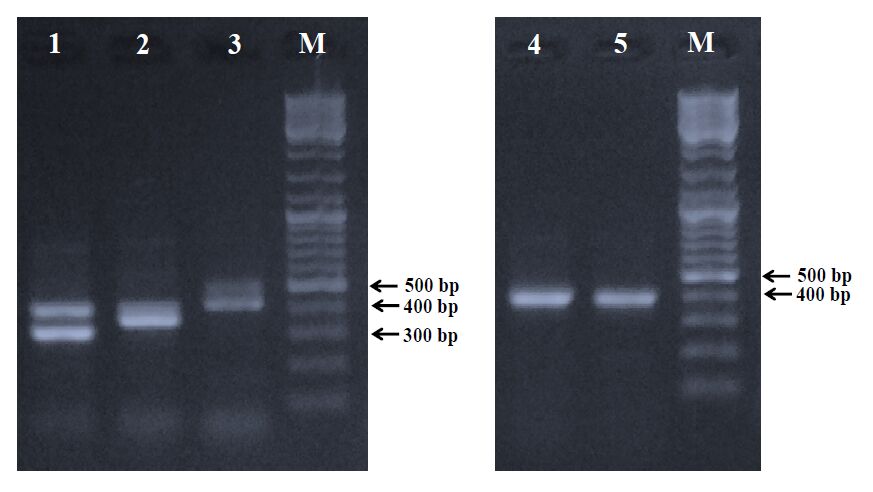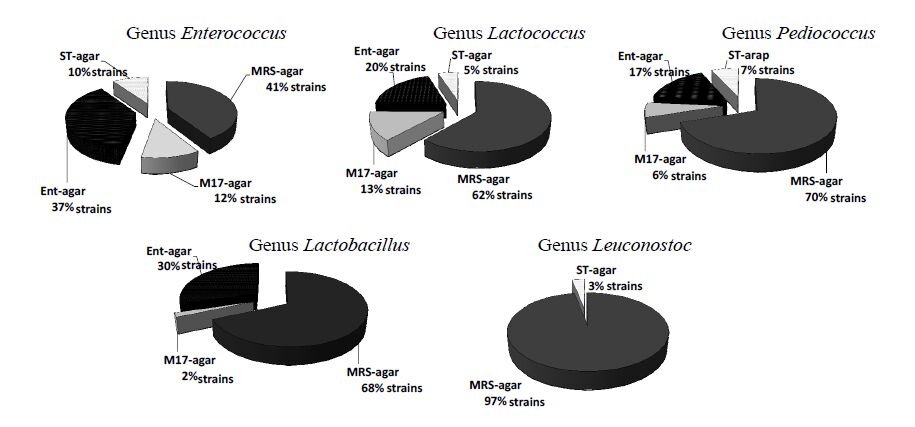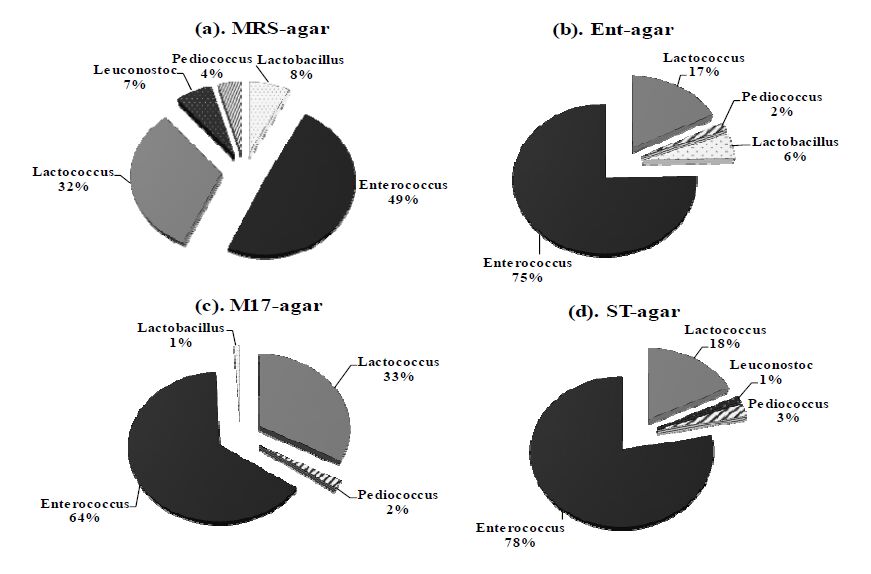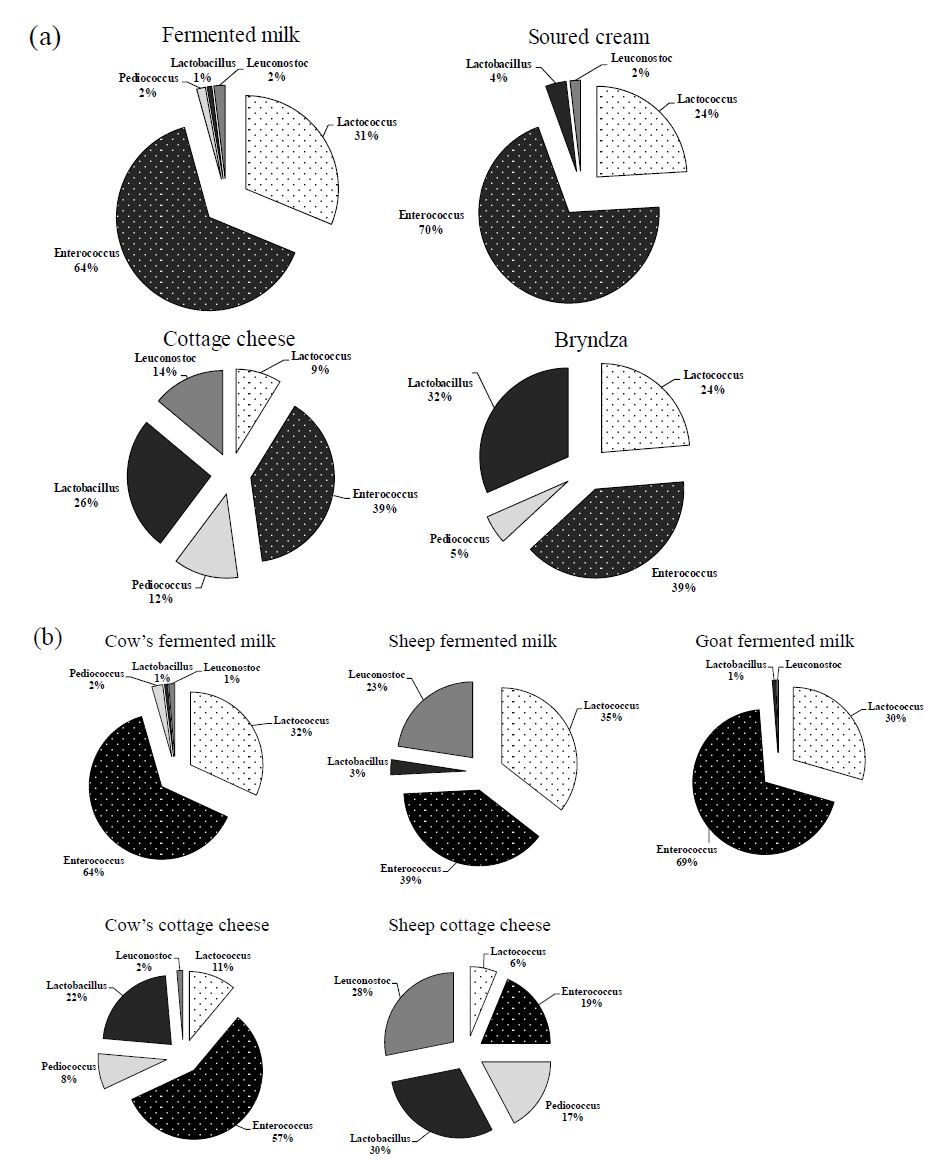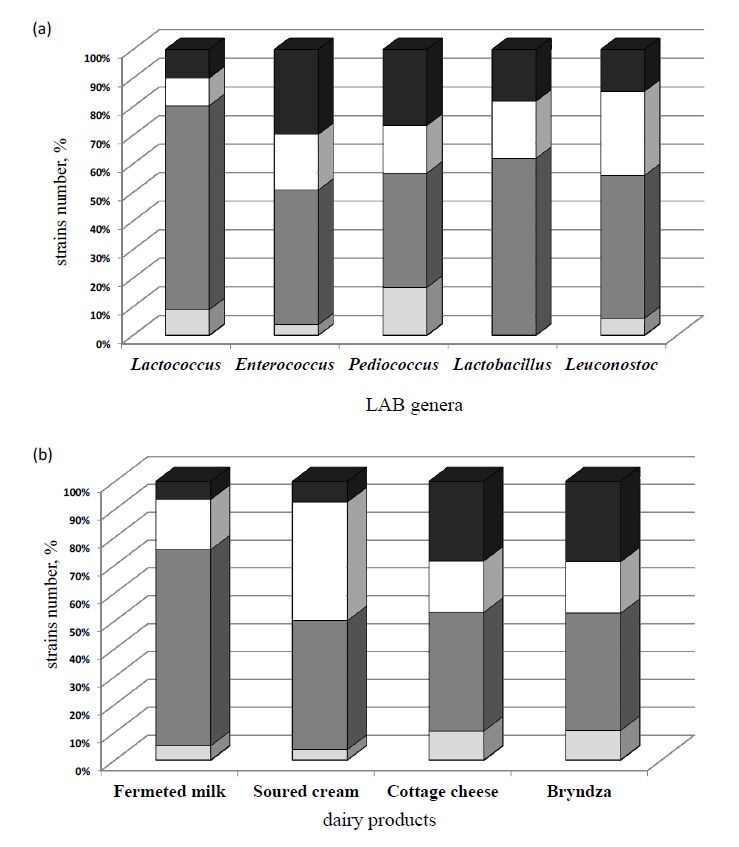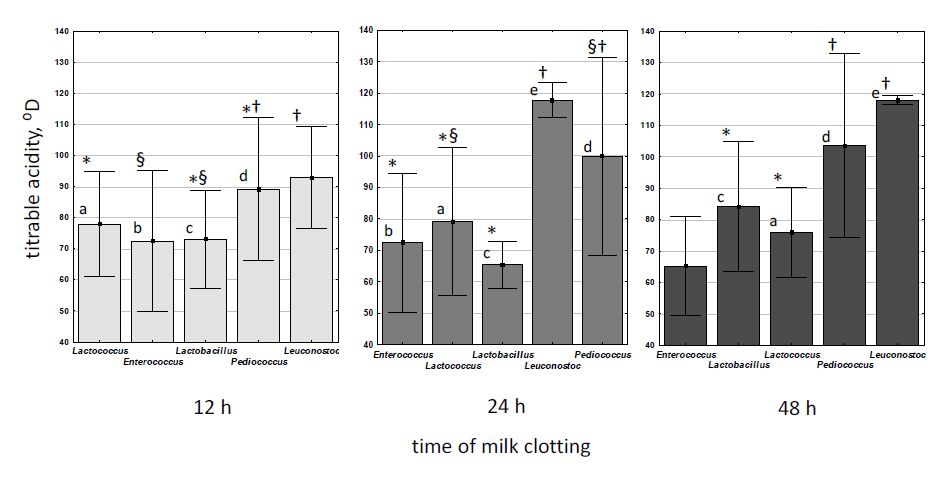1. Introduction
Fermented milk products are important as a source of a wide range of nutrients and have played a significant role in the diet of the rural population of Ukraine for many years. The cows are the major livestock species and provide most of the milk and dairy products in Ukraine. Fermented cow’s milk, soured cream and cottage cheese are widely consumed by people in all regions of Ukraine. Goat milk is the second most popular variety of milk in Ukraine. Goat’s milk has been described as having more easily digestible fat and protein content than cow’s milk. In addition, goat’s milk has an increased content of vitamin A, thiamine and niacin, and it could be a substitute in the consumption of cow’s milk [1]. In some regions, such as Carpathians in the West of the country, sheep’s milk is frequently used, mostly for production of cheese called bryndza manufactured either with sheep’s milk only or blended with cow’s milk. As a common technique for the manufacture of Ukrainian traditional artisanal dairy products, the raw non-pasteurized milk is left overnight in a glass jar to ferment in a warm place. On the second or third day, the upper layer of the fermented batch is collected as sour cream. In some cases the milk is first boiled for several minutes and a portion of a fermented milk or sour cream from a previous batch is used as an inoculum. For cottage cheese production the sour milk is warmed up and whey is removed. The cheese curd is collected in a cheesecloth, pressed and can be consumed directly. Bryndza is usually made from sheep’s cheese prepared from raw sheep’s milk or a mixture of sheep’s and cow’s cheeses. The rennet can be added to the milk before fermentation. Bryndza can be kept for several months in a mixture of water, whey, and salt.
Traditional dairy products have typical features that depend on local and regional customes. The properties of different dairy products depend on the environmental conditions such as the origin and pre-treatment of the milk used, the temperature of fermentation and subsequent processing and the sanitary conditions [2,3,4]. But the lactic acid bacteria (LAB) is the primary factor that contributes to their specific characteristics such as taste, aroma and texture and these characteristics play an important role in product acceptance by consumers [5]. The use of commercial starters has improved the technological quality of dairy products, but is partially responsible for the loss of the microbiota biodiversity and the typical organoleptic properties of artisanal dairy products [6]. The main technological properties of lactic acid bacteria in milk fermentation, such as acidification, texture enhancement and flavour production, are strain dependent [4,7]. In many countries, the search for new strains with functional properties is of great interest. As was shown by many authors, artisan dairy products, especially those produced from raw milk, are inexhaustible sources of LAB strains with diverse genetic profiles and novel functional properties [4,8,9,10]. Such LAB strains could be used for the production of traditional products on an industrial scale for the preservation of microbial populations present in traditional dairy products [7,11,12]. The characterisation and identification of lactic acid bacteria associated with theindigenous fermented milk products of many countries have been reported [13,14,15]. As was shown, LAB species of the genera Lactobacillus, Lactococcus, Leuconostoc, Pediococcus, Streptococcus, and Bifidobacterium have been identified in fermented milks and other dairy products using phenotypical tests and molecular-based techniques [15,16,17].
No research has to date been conducted on the diversity of predominant LAB in Ukrainian traditional artisan dairy products that were manufactured from cow’s, goat’s and sheep’s milks. The aim of this study was to isolate, identify and explore the diversity of the predominant LAB genera occurring in Ukrainian traditionally prepared dairy products such as fermented milks, soured cream, cottage cheese and bryndza. Additionally, for all isolated LAB strains, the milk clotting activity was preliminarily tested to assess their potential for industrial application and select the most appropriate strains for use as starter cultures.
2. Material and Methods
2.1. Sample collection and LAB isolation
The LAB were isolated from thirty-one samples of traditional dairy products collected from individual households and local markets in nine provinces in Ukraine, namely Kyevska, Chernihivska, Vinnytska, Poltavska, Zakarpatska, Odesska, Khmelnytska and Chernivetska. Sixteen of the samples were from fermented milks (12—cow’s fermented milks, 2—goat’s fermented milks, and 1—from sheep’s fermented milk), three from sour cream, 6 from cottage cheese (5 from cow’s cheese and 1 from sheep’s cheese) and seven samplesfrom bryndza. MRS agar [18] was used for isolation of lactobacilli (30 °C and 37 °C incubation), M17 agar [19] for isolationof lactococci, M-Enterococcus-agar (Ent-agar) [20] was used for isolation of enterococci, and ST-agar [21] for isolation of Streptococcus thermophilus. Thirty to fifty colonies per sample with different morphologies were randomly taken from agar plates, purified by streaking on the appropriate media and tested for catalase reaction, Gram staining and microscopic examination.
All isolates, which were catalase-negative and Gram-positive, were selected and preserved in the appropriate medium containing 30% glycerol at −50 °C and subcultured every 6 months. The cultures were activated by two successive transfers in the same broth before use.
2.2. Identification at genus level
The isolates were tested for cell morphology, physiological and biochemical properties as described previously [22].
The total DNA from LAB isolates was extracted from overnight cultures as described previously [23]. For identification of homofermentative cocci, amplification of the 16S-23S rRNA gene spacer region was performed using the primers G1 and L1 [24]. The PCR mixture and conditions were performed as described by [25]. For identification of enterococci a genus-specific PCR reaction was performed with primers Ent1 and Ent2 and conditions previously described by [26]. For further identification of lactococci, a multiplex PCR assay was performed with the 16S rRNA gene-based primers and conditions previously described [27]. The reference strains Enterococcus faecalis CCM 7000, E. faecium NCDO 942, E. durans NCDO 956, Lactococcus lactis subsp. lactis CCM 1877 and Lactococcus lactis subsp. cremoris CCM 2106 were used as control for the PCR analyses. The amplified PRC products were examined using 1.5% (w/v) agarose gels in TBE buffer with a DNA ladder GeneRuler 100 bp (Fermentas, USA).
2.3. Milk clotting activity
Acid production was determined in 10% skimmed milk. A 1% inoculum from an overnight culture was used to inoculate the milk, which was then incubated at 30 °C. Coagulation was visually determined at 12, 24 and 48 h. The titrable acidity (TA) was determined as°Dornic (°D). The acidifying activity was expressed as the difference between the acidity developed in clotted milk and the ones corresponding to the non-inoculated milk.All experiments were done in duplicates.
2.4. Statistical analysis
The data analysis was performed with Statistica 7.0 software (Statsoft Ltd, Chicago, IL, USA). A one-way analysis of variance (ANOVA) was applied to the results of the bacterial counts and acidifying capacity using the LSD post-hoc test for comparison of the means. Significance was determined at the P < 0.05 level.
3. Results
3.1. Isolation of LAB
In all samples of the Ukrainian traditional fermented milk products analysed, the total viable counts of LAB varied between 2.0×107 and 4.6×109 CFU/g. Slight variations of the viable counts of LAB were observed among dairy products. The statistical analysis indicates that the mean count of viable bacteria depends on the type of dairy product as well as the cultivation conditions used (Table 1). After incubation at 37°Сon MRS-agar LAB counts in fermented milk and bryndza samples were higher compared to the soured cream and cottage cheese samples. At the same time, the mean bacterial counts of the fermented milk and cottage cheese samples after incubation at 30°Сwere significantly higher compared to the soured cream and bryndza samples. The viable counts of LAB on M17-agar were the highest in fermented milk samples, the lowest—in the bryndza samples. The highest viable count of LAB on Ent-agar was in bryndza samples, however, no significant difference between the numbers of viable bacteria in other products was observed.
Table 1.The mean bacterial counts of LAB in Ukrainian dairy products at different cultivation conditions.
| Medium (cultivation temperature) | Log CFU/g* | | | |
| Fermented milk | Soured cream | Cottage cheese | Bryndza |
| MRS-agar (37 °C) | 8.73±0.49ae | 7.83±0.08bh | 8.08±0.72ch | 8.53±0.76eh |
| MRS-agar (30 °C) | 8.63±0.78af | 7.01±0.17bi | 8.28±0.38cf | 7.37±0.72i |
| M17-agar (30 °C) | 9.17±0.35 | 7.96±0.13bj | 8.16±0.73cj | 6.45±0.47d |
| Ent-agar (37 °C) | 5.36±0.69g | 4.80±0.57g | 5.43±0.39g | 6.17±0.57d |
| *: the values shown are means±standard deviations; a, b, c, d: different superscripts within the columns indicate significant differences according to LSD-test (P < 0.05); e, f, g, h, i, j: different superscripts within the rows indicate significant differences according to LSD-test (P < 0.05). |
The mean LAB count of fermented milk samples was the highest on MRS-agar, the lowest—on M17-agar. The mean LAB counts of soured cream and cottage cheese were lower on Ent-agar compared to other medium used. The mean LAB count of bryndza samples was the highest on MRS-agar, and the lowest—on M17-agar and Ent-agar. The mean counts of LAB in fermented milk, soured cream and cottage cheese were almost identical at 37 °C and 30 °C incubation on MRS-agar, whereas in bryndza LAB count at 37 °C was significantly higher than at 30 °C incubation on MRS-agar. The viable LAB counts on ST-agar varied between 1.0×106 and 3.0×107 CFU/g, but LAB were detected only in five product samples from 31 used, namely three fermented cow’s milks, one fermented goat’s milk and 1 cottage cheese from cow milk. So, this data were not included in statistical analysis.
In total, 950 presumptive LAB strains were isolated from 31 samples of dairy products, made from cow’s, goat’s and sheep’smilk. Firstly the strains were grouped on the basis of cell morphology and production of gas from glucose, and three groups were obtained. Among the homofermentative cocci (group 1), most of the isolates showed ovoid cells that occurred singly, in pairs or chains of different lengths, some isolates showed coccoid cells, grouped into in clusters or tetrads. Almost all of them could grow at 10 °C, in the broth with 4% NaCl, and produce NH3 from arginine. Some of them could grow at 45 °C and in the broth with 6.5% NaCl. The homofermentative cocci with spherical cells grouped in clusters or tetrads could be presumptively classified as belonging to the genus Pediococcus. So, the results showed that among the homofermentative coccal isolates, the majority belonged to genera Enterococcus and Lactococcus and small number of strains—to Pediococcus.
Group 2 isolates consisted of homofermentative rods, most of them (38 from 55 strains) were identified in our previous work at L. plantarum [28]. In this work the remaining rod strains were also belonged to genera Lactobacillus and presumptively identified as L. plantarum, based on phenotypic characteristics mentioned in our previous work [28], with exception of three strains Lactobacillus sp. Heterofermentative isolates of group 3 showed the typical leuconostoc-like ovoid cell shape and were arginine-negative and vancomycin resistant. Most of them also formed dextran from sucrose. So, the heterofermentative coccoid strains were identified as belonging to the genus Leuconostoc.
Enterococci could be distinguished from lactococci by their ability to grow at 45 °C and 10 °C and in the broth with 6.5% NaCl. At the same time, the results obtained by authors [9,29] suggest that growth at different temperatures and salt concentrations might be strain dependent. So, most of the homofermentative cocci strains were difficult to identify at genus level, because they fall into one or two traits of those that conformed to the taxonomic identification and only some isolates had the typical physiological characteristics of Enterococcus sp. or Lactococcus sp. strains. So, following preliminarily phenotypic characterization the homofermentative coccus isolates were identified by PCR amplification of the 16S-23S rRNA gene spacer region. The majority (572 isolates) of the homofermentative cocci and three reference Enterococcus type strains were grouped together according to the presence of two main amplification bands and were identified as members of Enterococcus genus with specific amplification product (112 bp) by using genus-specific primers Ent1 and Ent 2 [26]. The remaining 259 isolates and reference L. lactis strain one amplification band with size about 400 bp were obtained. Species-specific multiplex PCR reactions yielded an amplicon of 238 bp [27] for the all isolates and reference strain L. lactis subsp. Lactis (Figure 1).
So, the genus identification of the 950 isolates showed the presence of five LAB genera in Ukrainian dairy products, namely Enterococcus sp. (60% isolates), Lactococcus sp. (27%), Lactobacillus sp. (6%), Leuconostoc sp. (3.5%) and Pediococcus sp. (3%).
In our work LAB strains were isolated using four different cultivation mediums (Figure 2). Enterococci, lactococci and pediococci were isolated from all media used. Leuconostoc spp. strains were mostly isolated from MRS-agar and a few strains—from ST-agar. No lactobacilli were isolated from ST-agar, and at the same time 30% of Lactobacillus strains were isolated from Ent-agar. The MRS and M17 media are used usually for the isolation and counting of LAB from most fermented food products. In our work most of LAB strains were isolated from MRS-agar, among them lactic acid cocci were dominating. Only 8% of strains isolated on MRS-agar were lactobacilli. So, MRS-agar showed a low degree of selectivity for genus Lactobacillus, despite this medium being described as a medium for the isolation and cultivation of lactobacilli [18]. In contrast, on M17-agar mostly enterococci and lactococci were isolated. The Ent-agar showed relatively high selectivity for genus Enterococcus (75% of isolates), although lactococci, pediococci and even lactobacilli were isolated on this medium (Figure 3). The ST-agar was described as a medium for the selective isolation of S. thermophilus, the cultures of S. thermophilus formed well-developed, yellow colonies on ST-agar plates within 24 h of incubation [21]. But no S. thermophilus strains were isolated in our work, all strains isolated on ST-agar were identified as enterococci, lactococci, pediococci or leuconostocs. Similarly to our results, the absence of S. thermophilus in traditional milk products was reported [29,30,31]. Our results are also consistent with the results of otherstudies, in which the lack of selectivity of culture media in studying biodiversity in different dairy products has been shown [3,14,31].
The diversity of the isolated LAB strains was correlated with the type of product and the source of milk. The distribution of isolates among different dairy products is presented in Figure 4. In all dairy product samples enterococci, lactococci and lactobacilli were found. Strains of the Pediococcus spp. and Leuconostoc spp. were also isolated, but with a lower incidence, with the exception of bryndza and soured cream samples, in which Leuconostoc spp. and Pediococcus spp. were not found respectively (Figure 4a). Leuconostocs were isolated mainly from products, made from sheep’s milk (Figure 4b). Such distribution could be influenced by various factors including the variable chemical composition of the milk and the specificities of the production process as well as the geographical location. The presence of enterococci in fermented milk and soured cream can be associated with the use of non-pasteurized milkand is probably due to fecal contamination of milk during milking. The resistance of enterococci to high temperatures may explain why they can be found in cheese and bryndza, which involves warming up the sour milk. The chemical composition of soured cream, particularly its high fat content, as well as warming up the soured milk during the manufacturing of cottage cheese, or high salt content in brynza, could have prevented the growth of some LAB. Our study results are similar to those published by Terzic-Vidojevic et al. [17] who reported this regarding the differences in the distribution of LAB in sweet kajmak samples, related to LAB isolated from young cheeses and sweet creams and the technological process had a major effect on the composition of the LAB of these products.
3.2. Acidification and milk clotting activities
For the preliminary characterization of technological properties, 950 LAB isolates were tested for their ability to coagulate reconstituted skimmed milk at 30 °C. Interestingly, 5.4% (51 from 950) of the strains were unable to clot milkwithin 72 h of the incubation. Other LAB strains were able to clot milk. Among them 517 strains curdled skimmed milk within 12 h, 162 strains—within 24 h, and 219 strains—within 48 h of the incubation. More than 60% of Lactococcus and Lactobacillus strains caused coagulation of milk within 12 h, whereas among Enterococcus, Pediococcus and Leuconostoc strains—not more than 50% (Figure 5a). The time of milk clotting also correlated with the product from which strains were isolated (Figure 5b). The majority (70%) of isolates from fermented milk coagulated milk within 12 h, whereas in other products the number of such strains did not exceed 45%. The frequency of isolation LAB strains which caused coagulation of milk within 24 h was much higher for soured cream (43%) compared to fermented milk, cottage cheese and bryndza (18%). The frequencies of isolation LAB strains which caused coagulation of milk within 48 h, and strains which were unable to clot milk were much higher for cottage cheese and bryndza (28% and 10%, respectively) compared to soured cream and fermented milk (7% and 4-5%, respectively).
In addition, the LAB strains were grouped according to the time of milk clot formation, and the average titrable acidity of clots was calculated according to LAB genera (Figure 6). The acidifying activity was variable among different LAB genera. There were statistically significant differences (P < 0.05) in average titrable acidity of milk clots according to time of milk clot formation and LAB genera. Milk clots inoculated with Enterococcus strains within 12 h or 24 h contained higher level of lactic acid, compared to milk clots obtained within 48 h, whereas average titrable acidity of clots obtained with Leuconostoc strains within 12 h was lower compared to 24 h and 48 h. The average titrable acidity of milk clots prepared with Lactococcus, Pediococcus and Lactobacillus strains was similar (P > 0.05), regardless with the coagulation time. Generally, strains belonging to the Leuconostoc and Pediococcus genera showed a greater acidifying capacitycompared to other LAB genera.
4. Discussion
The LAB composition of the Ukrainian artisanal dairy products indicates that enterococci are the dominant microflora in almost all dairy products examined in this study. The presence of enterococci in traditional dairy products have been reported by many authors [3,4,15,17]. Enterococci are a major component of the natural microflora of the artisanal cheeses produced in Southern Europe [32].
In contrast to the enterococci, the lactococci were present in relatively small percentage in Ukrainian dairy products samples. In this study, the highest frequency of L. lactis was found in fermented milk samples (31%), and the lowest frequency of L. lactis ssp. lactis—in cottage cheese samples (9%), probably because the Lactococcus strains did not survive the warming up of the sour milk. Lactococci are the most frequently isolated LAB group in traditional dairy products [3,17,30].
In our previous [28] and the current study, almost all lactobacilli strains were identified as L. plantarum and isolated at relatively high frequencies from bryndza and cottage cheese samples (32% and 26%, respectively), compared to soured cream and fermented milk samples (4% and 1%, respectively). The L. plantarum strains are commonly associated with plant-based food fermentations [33]. But in many studies, L. plantarum was found to be predominant among Lactobacillus species in dairy products [34,35].
In this study, only 34 strains (3.5% of total isolates) of Leuconostoc spp. were isolated. Leuconostocs were isolated from fermented milk, soured cream and cottage cheese samples, but could not be detected in bryndza. The presence of Leuconostoc spp. in traditional dairy products of different countries has been reported [13,17,36]. Leuconostoc species generally showed a weak competitive ability during fermentation of milk and lower adaptation to milk [4,33].The higher percentage of Leuconostoc strains isolated from sheep’s milk product samples could be explained by the higher number of rich nutrients provided by sheep’s milk compared to cow’s and goat’s milks.
The occurrence of Pediococcus species in Ukrainian artisanal dairy products was low, only 3% of total isolated LAB strains. The isolation of pediococci from traditional dairy products is not common [14,38,39]. The strains of this genus were isolated much less often than other LAB cocci [39,40].
So the variability of the LAB strains isolated from the samples tested reflects their artisan production. In this study, enterococci were isolated from all traditional dairy products examined. The importance of enterococci in dairy products is controversial [41]. This result may indicate that there are problems in sanitation during the manufacturing process of some products [42]. However, it has been demonstrated that the common presence of Enterococcus strains in many food products is not always related to direct faecal contamination, but these species might be considered as autochthonous parts of the food microbiota [43]. At the same time, the presence of enterococci in Ukrainian traditional artisanal dairy products should be looked at critically, as enterococci might carry virulence factors and antibiotic-resistance genes [44,45].
The ability of the LAB strains to produce lactic acid rapidly is the primary criterion in the selection of strains to be used as starter cultures [46]. Some of the tested LAB strains were unable to coagulate milk, that is in agreement with authors that reported about Lactococcus strains which could not grow in milk, although they were isolated from fermented milk [47]. The most (54%) of the LAB strains isolated from Ukrainian traditional dairy products showed a potentially good acidifying activity and coagulated milk within 12 h. The milk coagulation rate was not strongly dependent on the LAB genus and was strain dependent. The results found in this work are in accordance with those reported by many authors. The best activity in milk was mainly exhibited by Lactococcus lactis strains, that coagulated milk during 4 to 6 h of incubation [48], and other authors reported the slow milk-coagulating capacity of lactococci isolated from artisanal products [38,49]. Enterococcus strains also showed high acidifying activity [50] as well as slow acid production in milk [51]. Leuconostoc strains with good acidifying activity were isolated from dairy products by Bendimerad et al. [52] and Nieto-Arribas et al. [7]. At the same time Morandi et al. [10] reported that leuconostocs strains isolated from cheese had weak acidifying activity in milk.
5. Conclusion
In conclusion, the first systematic study of the LAB genus diversity in Ukrainian artisanal dairy products showed that it mainly consists of the five genera, namely Enterococcus, Lactococcus, Lactobacillus, Leuconostoc and Pediococcus. The obtained results from this study suggest that distribution of LAB genera varied among fermented milk, soured cream, cottage cheese and bryndza samples. Such differences in LAB distribution could be due to the different manufacturing processes as well as milk composition. Traditional Ukrainian dairy products can be a source of new LAB strains with potentially good technological and functional properties. The results of this work show great variability within the acidifying activity. Coagulation of milkby the majority of LAB strains showed their potential as starters or adjunct cultures. Therefore identification of varied technological properties of isolated LAB strains will be conducted in order to determine their usefulness for development of a starter culture preparations.
Acknowledgments
The author wishes to thank Prof. N.K. Kovalenko for helpful comments. The author also thanks O.M. Vasyliuk and L.T. Oleschenko for their skilful technical assistance in PCR analysis and determining of acidification activity.
Conflict of Interest
All authors declare no conflicts of interest in this paper.









 DownLoad:
DownLoad: 